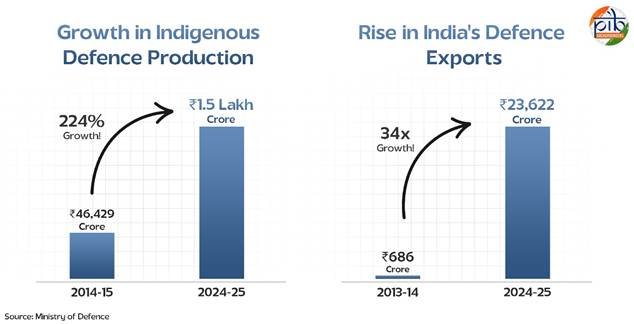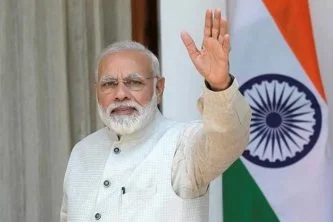New Delhi: In what is a mid-year appraisal of the nation’s security scenario, an official release said that in the last eleven years, India’s defence and internal security posture under the government of Prime Minister Narendra Modi has undergone a profound transformation.
The shift has been marked by greater clarity of purpose, stronger deterrence, and a sustained drive for self-reliance. This government has consistently underlined that national security is non-negotiable, and to ensure this security India will build her own capacity and preparedness. This has resulted in a more confident, modern, and proactive approach to challenges both external and internal. Unlike in the past, India under the present Government has become a global force to reckon with, a nation that speaks on issues from a position of strength.
 The appraisal noted that India’s defence expenditure has steadily increased under the present Government, rising from ₹2.53 lakh crore in 2013–14 to ₹6.81 lakh crore in 2025–26. The focus is no longer only on acquiring weapons but also on building domestic capacity. In 2024–25, defence production touched a record ₹1.50 lakh crore, more than triple the 2014–15 level. Fighter jets, missile systems, artillery systems, warships, naval vessels, aircraft carriers and a lot more are now being made in India, underlining how strongly self-reliance and deterrence have become the cornerstone of national security. Defence exports grew thirty-four times over the last decade, reaching ₹23,622 crore in 2024–25. Indian equipment is now exported to over 100 nations, including the United States, France, and Armenia.
The appraisal noted that India’s defence expenditure has steadily increased under the present Government, rising from ₹2.53 lakh crore in 2013–14 to ₹6.81 lakh crore in 2025–26. The focus is no longer only on acquiring weapons but also on building domestic capacity. In 2024–25, defence production touched a record ₹1.50 lakh crore, more than triple the 2014–15 level. Fighter jets, missile systems, artillery systems, warships, naval vessels, aircraft carriers and a lot more are now being made in India, underlining how strongly self-reliance and deterrence have become the cornerstone of national security. Defence exports grew thirty-four times over the last decade, reaching ₹23,622 crore in 2024–25. Indian equipment is now exported to over 100 nations, including the United States, France, and Armenia.
India’s defence policy in the last decade has been guided by the principle of Aatmanirbharta. Prime Minister Modi led government has pushed through structural reforms to reduce import dependence, boost indigenous production, and build a globally competitive defence ecosystem. The reforms span procurement, research, industry participation, and foreign investment. The Defence Acquisition Procedure 2020, revised from DPP 2016, aligned fully with the Aatmanirbhar Bharat Abhiyan spearheaded by PM Modi. It prioritises the Buy (Indian – Indigenously Designed, Developed and Manufactured) category for acquisitions, ensuring maximum reliance on local design, development, and manufacturing. This shift places Indian-IDDM projects at the top of the procurement pyramid.
The Make procedure was streamlined to encourage Indian industry to participate in design, development and manufacturing of Defence platforms/systems. Projects under the Make categories, with procurement upto Rs 100 crore/year are earmarked for MSMEs. So far, 146 projects of Army, Navy, Air Force and HQ IDS have been accorded ‘Approval in Principle’ under various ‘Make’ categories.
To attract capital and advanced technology, FDI in defence was liberalized with 74% permitted via automatic route for new industrial licenses and up to 100% allowed through government approval in cases involving advanced technology.
Innovations for Defence Excellence (iDEX), launched in 2018, supports start-ups, MSMEs, and academia with grants for defence innovation. Technology Development Fund (TDF) provides grants up to ₹10 crore for MSMEs and start-ups to build advanced defence and aerospace technologies. The SRIJAN Portal (2020) enables industry to locally develop items earlier imported. To date, over 46,798 items have been listed.
Positive Indigenisation Lists by DPSUs have identified 5,012 items (across five tranches), signaling a phased ban on imports. The Offset Portal (2019) has enhanced transparency in offset contracts, encouraging OEMs to invest in Indian manufacturing and sourcing defence products from India for global supplies. The Strategic Partnership (SP) Model (2017) allows Indian firms to tie up with global OEMs, enabling technology transfer and joint infrastructure creation in India.
India has signed multiple agreements to support domestic manufacturing. Notably, the 2019 Inter-Governmental Agreement with Russia enables joint production of spares for Russian-origin platforms in India, reducing dependence on imports and improving operational readiness. Industrial license requirements for many parts/components have been removed. License validity extended from 3 to 15 years (with 3-year extension).
R&D has been opened to industry, start-ups, and academia, with 25% of the defence R&D budget earmarked for them. The government has created the Defence AI Council (DAIC) and Defence AI Project Agency (DAIPA) to promote adoption of artificial intelligence in defence systems. Each DPSU has finalised an AI roadmap. DRDO has identified nine thrust areas for research: Platforms, Weapon Systems, Strategic Systems, Sensors and Communication, Space, Cyber Security, AI and Robotics, Materials and Devices, and Soldier Support.

India has adopted a firm and clear approach towards cross-border terrorism. The pattern of action over the last decade reflects this policy. After the Uri attack in 2016, India carried out surgical strikes across the Line of Control. Following the Pulwama attack in 2019, India launched precision air strikes on a terrorist camp in Balakot.
The most recent and defining operation came in May 2025 with Operation Sindoor. In response to the killing of civilians in Pahalgam, India gave its armed forces full freedom of action. Using drones and precision munitions, they struck nine terrorist camps in Pakistan and Pakistan-occupied Jammu and Kashmir. More than one hundred terrorists were eliminated, including individuals linked to the IC-814 hijacking and the Pulwama attack. Pakistan attempted retaliatory strikes through drones and missiles, but Indian counter-drone systems neutralised them.
In his Independence Day address of 2025, PM Modi described Operation Sindoor as “a new normal,” making it clear that India will respond with full force whenever terrorism threatens its citizens.
Beyond immediate responses, the Modi government is preparing for long-term threats. In his 2025 Independence Day speech, PM Modi announced the Sudarshan Chakra Mission, a futuristic defence programme. Its goals are threefold: to ensure the entire system is researched, developed, and manufactured in India; to anticipate future warfare scenarios through predictive technologies; and to create precise, targeted systems for counter-action. By 2035, the aim is to provide a comprehensive national security shield for both strategic and civilian assets.
Internal security has also seen significant gains under this government. Left-Wing Extremism (LWE), once a severe challenge, has been brought under control. The number of affected districts has fallen to fewer than twenty. More than 8,000 Naxalites have abandoned violence in the last decade. Incidents of extremist violence, which stood at 1,936 in 2010, dropped to 374 in 2024. Civilian and security force casualties fell by 85 percent in the same period.






